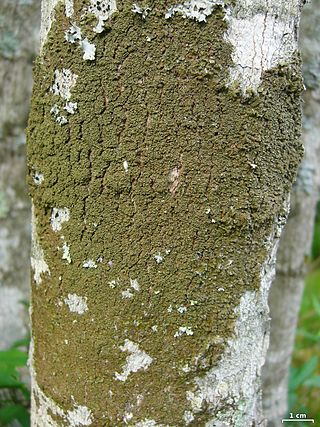
Parmelia is a genus of medium to large foliose lichens. It has a global distribution, extending from the Arctic to the Antarctic continent but concentrated in temperate regions. There are about 40 species in Parmelia. In recent decades, the once large genus Parmelia has been divided into a number of smaller genera according to thallus morphology and phylogenetic relatedness.
Chroodiscus is a genus of leaf-dwelling lichens in the family Graphidaceae. It was first introduced by Swiss lichenologist Johannes Müller Argoviensis in 1883 as a section of the genus Ocellularia. In 1890 he promoted it to generic status.

Melanohalea is a genus of foliose lichens in the family Parmeliaceae. It contains 30 mostly Northern Hemisphere species that grow on bark or on wood. The genus is characterized by the presence of pseudocyphellae, usually on warts or on the tips of isidia, a non-pored epicortex, and a medulla containing depsidones or lacking secondary compounds. Melanohalea was circumscribed in 2004 as a segregate of the morphologically similar genus Melanelia.

Melanelixia is a genus of foliose lichens in the family Parmeliaceae. It contains 15 Northern Hemisphere species that grow on bark or on wood. The genus is characterized by a pored or fenestrate epicortex, and the production of lecanoric acid as the primary chemical constituent of the medulla. Melanelixia was circumscribed in 2004 as a segregate of the related genus Melanelia.

Dalip Kumar Upreti is an Indian lichenologist. He served as Director and Chief Scientist at CSIR-National Botanical Research Institute, Lucknow during 1988 to 2017. Also he served as Head of Lichenology and herbarium division. Presently he is serving as CSIR-Emeritus Scientist in the same division.
Parmotrema abessinicum is a species of corticolous lichen in the family Parmeliaceae. It has been recorded from Africa, Asia, and Oceania.
Emodomelanelia is a lichen genus in the family Parmeliaceae. It is monotypic, containing the single foliose Himalayan species Emodomelanelia masonii.

Notoparmelia is a genus of foliose lichens in the family Parmeliaceae. It includes 18 species that grow on bark and rocks, and are mostly distributed in the Southern Hemisphere. The genus was created in 2014 as a segregate of Parmelia.
Austromelanelixia is a genus of five species of foliose lichens in the family Parmeliaceae. All species are found in the Southern Hemisphere.
Helge Thorsten Lumbsch is a German-born lichenologist living in the United States. His research interests include the phylogeny, taxonomy, and phylogeography of lichen-forming fungi; lichen diversity; lichen chemistry and chemotaxonomy. He is the Associate Curator and Head of Cryptogams and Chair of the Department of Botany at the Field Museum of Natural History.
Melanohalea nilgirica is a species of foliose lichen in the family Parmeliaceae. Found in India, it was described as a new species in 2005 by lichenologists Pradeep Divakar and Dalip Kumar Upreti. The type was collected from the Nilgiri Hills in Tamil Nadu, at an elevation of 2,000 m (6,600 ft). Its thallus is about 6 cm (2.4 in) in diameter, with a reddish-brown to dark brown upper surface. It is characterized by flat, dot-like pseudocyphellae that are flush with the lobe surface, white capitate soralia, and presence of caperatic acid. This is the only known occurrence of this compound in the genus Melanohalea.
Ocellularia aptrootiana is a species of corticolous lichen in the family Graphidaceae. Found in Sri Lanka, it was formally described as a new species in 2014 by lichenologists Gothamie Weerakoon, Robert Lücking, and Helge Thorsten Lumbsch. The type specimen was collected from Mahailluppallama at an altitude of 170 m (560 ft). Here, in a low-altitude, dry, semi-evergreen forest, it was found growing around a water tank. The specific epithet aptrootiana honours Dutch lichenologist André Aptroot, "for his important contributions to tropical lichenology and his help with the research by the first author". Ocellularia aptrootiana has a grey, smooth to uneven or cracked thallus up to convert 5 cm (2 in) in diameter. The ascospores are hyaline, ellipsoid in shape, contain seven septa, and measure 20–25 by 6–7 μm. Secondary chemicals present in the lichen include psoromic acid, subpsoromic acid, and 2’-O-demethylpsoromic acids.
Ocellularia balangoda is a species of corticolous lichen in the family Graphidaceae. Found in Sri Lanka, it was formally described as a new species in 2014 by lichenologists Gothamie Weerakoon, Robert Lücking, and Helge Thorsten Lumbsch. The type specimen was collected from a high-altitude tea estate in Hunnasgiriya at an altitude of 1,240 m (4,070 ft); here it was found growing on tree trunks. The specific epithet refers to the prehistoric hominids known as Balangoda Man, who lived in Sri Lanka about 38,000 to 28,500 years ago. Ocellularia balangoda has a grey thallus up to 5 cm (2 in) in diameter, with a papillose (pimply) to verrucose (warty) textured surface. The ascospores are hyaline, ellipsoid in shape, contain seven septa, and measure 25–30 by 5–7 μm. Secondary chemicals present in the lichen include protocetraric acid and virensic acid.
Ocellularia cloonanii is a species of corticolous lichen in the family Graphidaceae. Found in Sri Lanka, it was formally described as a new species in 2014 by lichenologists Gothamie Weerakoon, Robert Lücking, and Helge Thorsten Lumbsch. The type specimen was collected from a high-elevation montane forest in the Fishing Hut Tea Estate at an altitude of 1,870 m (6,140 ft). The lichen is only known to occur at the type locality in the Horton Plains. The specific epithet cloonanii honours Colman Patrick Cloonan, "for his immense help in carrying out the research studies". Ocellularia cloonanii has an olive-grey thallus up to 5 cm (2 in) in diameter, with continuous but uneven surface. Its ascospores are hyaline, ellipsoid in shape, contain seven to nine septa, and measure 35–40 by 7–10 μm. Secondary chemicals present in the lichen include psoromic acid, subpsoromic acid, and 2’-O-demethylpsoromic acid.
Ocellularia raveniana is a species of corticolous lichen in the family Graphidaceae. Found in Sri Lanka, it was formally described as a new species in 2014 by lichenologists Gothamie Weerakoon, Robert Lücking, and Helge Thorsten Lumbsch. The type specimen was collected from a high-elevation tea estate in Matale at an altitude of 1,360 m (4,460 ft). The lichen is only known to occur at the type locality and in the Sabaragamuwa Mountain Range. The specific epithet raveniana honours botanist and environmentalist Peter H. Raven, longtime director and now President Emeritus of the Missouri Botanical Garden. Ocellularia raveniana has a cream-colored to white thallus up to 10 cm (4 in) in diameter, with an uneven to somewhat verrucose (warty) surface. Its ascospores are hyaline, oblong to ellipsoid in shape, contain seven to nine septa, and measure 25–35 by 8–10 μm. Secondary chemicals present in the lichen include protocetraric acid, and virensic acid.
Lecanora luteomarginata is a species of saxicolous (rock-dwelling) and crustose lichen in the family Lecanoraceae. Found in India, it was formally described as a new species in 2006 by Sanjeeva Nayaka, Dalip Kumar Upreti, and H. Thorsten Lumbsch. The type specimen was collected in the trail from Gaurikund to Rambara in the valley of the Mandakini River at an elevation ranging from between 1,980 and 2,800 m. It is only known from the type locality. Characteristics of the lichen include its thin, smooth thallus, dark brown apothecia with bright yellow margins, melacarpella-type amphithecia and glabrata-type epihymenia. The specific epithet luteomarginata refers to the yellow-coloured apothecial margins. Secondary compounds in the lichen include arthothelin, atranorin, chloroatranorin, and thiophanic acid.
Ocellularia rivasplatiana is a species of corticolous (bark-dwelling) lichen in the family Graphidaceae. Found in Singapore, it was formally described as a new species in 2015 by Gothamie Weerakoon and Robert Lücking. The type specimen was collected by the first author from a low-elevation primary forest in the Bukit Timah Nature Reserve. It is only known to occur at the type locality. The species epithet honours lichenologist Eimy Rivas Plata.
Astrothelium aurantiacocinereum is a species of corticolous (bark-dwelling), crustose lichen in the family Trypetheliaceae. It occurs in New Caledonia.
Astrothelium fijiense is a species of corticolous (bark-dwelling), crustose lichen in the family Trypetheliaceae. Found in Fiji, it was formally described as a new species in 2016 by Robert Lücking, Khwanruan Naksuwankul, and Helge Thorsten Lumbsch. The type specimen was collected from Nakoba Levu at an altitude of 750 m (2,460 ft); there, it was found growing on bark on a steep slope in a secondary forest. The lichen has a smooth to uneven, light olive-yellow thallus that covers areas of up to 5 cm (2 in) in diameter. Both the thallus and the pseudostromata contain lichexanthone, a lichen product that causes these structures to fluoresce a yellow colour when lit with a long-wavelength UV light. The species epithet fijiense refers to the type locality. The characteristics of the lichen that distinguish it from others in genus Astrothelium are the distinctly pseudostromatic ascomata, and the presence of lichexanthone on the pseudostromata. Astrothelium cinereorosellum is somewhat similar, but that species has slightly longer ascospores and does not have lichexanthone on the pseudostromata.




